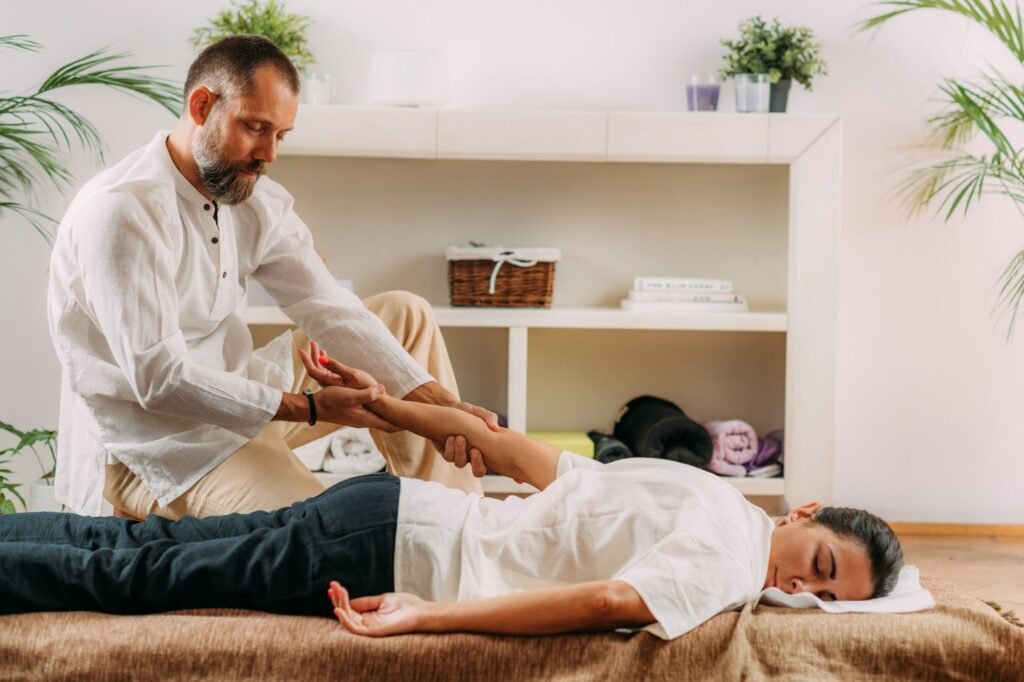Zenthai Shiatsu

Zenthai Shiatsu
Zenthai Shiatsu is a distinctive form of bodywork that merges the ancient wisdom of Eastern healing traditions with modern movement and therapeutic techniques. Within the holistic wellness realm, Zenthai Shiatsu is embraced for its ability to restore balance, promote structural realignment, and revitalize the flow of energy within the body, allowing for the release of tension, pain, and emotional blockages.
What is Zenthai Shiatsu?
Key principles of Zenthai Shiatsu include:
- Shiatsu Roots: Founded on the foundation of Japanese Shiatsu massage, employing pressure along acupoints to harmonize energy flow.
- Traditional Chinese Medicine (TCM): Incorporates the concept of Qi (vital energy) and meridians (energy channels) to guide treatment.
- Zen Thai Flow: Unique dynamic stretches and movements facilitate realignment of the skeletal structure and deep release of tense tissues.
- Holistic Approach: Views the body, mind, and spirit as interconnected, with sessions tailored to the individual’s needs.
- Osteopathic Influence: Some principles of osteopathic manipulation are echoed in its structural realignment focus.
How can Zenthai Shiatsu help you?
Zenthai Shiatsu is a powerful tool for:
- Releasing Physical Tension: Deep pressure, stretching, and mobilization of joints aids in loosening muscles and releasing deep-seated tension.
- Improving Structural Alignment: Focuses on realigning the skeletal system for improved posture and ease of movement.
- Enhancing Energy Flow (Qi): Addresses blockages in meridians to promote a sense of balance and well-being.
- Reducing Pain: Addresses the muscular and energetic imbalances that contribute to chronic pain.
- Promoting Relaxation and Stress Reduction: Induces a state of deep relaxation, supporting healing on both a physical and emotional level.
What is Zenthai Shiatsu good for?
Zenthai Shiatsu might be particularly beneficial if you:
- Experience Chronic Pain: Aids in addressing underlying structural or energetic factors contributing to pain.
- Desire Improved Flexibility: Releases muscular tension and increases joint range of motion, improving overall flexibility.
- Seek Stress Relief: Promotes deep mind-body relaxation, alleviating the harmful effects of stress.
- Enjoy Bodywork with Movement: If traditional massage feels too passive, the dynamic movements are often appealing.
- Yearn for Holistic Healing: Addresses interconnected aspects of well-being: physical, energetic, and emotional.
Benefits of Zenthai Shiatsu
Zenthai Shiatsu offers potential benefits such as:
- Chronic Pain Relief: Addresses both muscular and energetic components of pain, potentially providing lasting results.
- Improved Posture: Structural realignment work promotes optimal spinal health and reduces muscle imbalances.
- Enhanced Energy and Vitality: Removes blocks in Qi flow leading to an increased sense of well-being and vitality.
- Stress Reduction and Emotional Wellbeing: Induces deep relaxation, aiding in stress management and emotional healing.
- Greater Body Awareness: Cultivates a deeper connection with your body and its innate wisdom.
What to expect from Zenthai Shiatsu with a practitioner
A typical Zenthai Shiatsu session involves:
- Initial Consultation: Discussion of your health history, current concerns, and specific goals for the session.
- Comfortable Floor-Based Setting: Often occurs on a mat, unlike raised tables, facilitating dynamic movement.
- Clothing Remains On: Wear loose, comfortable clothing to allow for freedom of movement during the bodywork.
- Combination of Techniques: Includes Shiatsu pressure, joint mobilization, gentle rocking, and flowing Zen Thai Flow stretches.
- Open Communication: Encouraged to communicate your comfort level and provide feedback throughout the process.
Similar Modalities to Zenthai Shiatsu
Other modalities share similarities with certain aspects of Zenthai Shiatsu:
- Thai Massage: Shares movement-based aspects, though less focused on meridians and acupoints.
- Tuina: Chinese acupressure massage utilizing points for specific ailments, but lacks Zenthai’s unique movements.
- Osteopathy: Shares focus on structural alignment; lacks the energetic flow and traditional Chinese medicine aspects.
- Rolfing: Focuses on connective tissue manipulation for structural change, but can be more intense.
Final Thoughts
Zenthai Shiatsu offers a truly unique pathway to healing and rejuvenation. By blending the wisdom of traditional Eastern modalities with modern anatomical understanding and dynamic movement, Zenthai Shiatsu stands as a testament to the body’s inherent capacity for self-healing. If you seek a bodywork experience that addresses pain, promotes flexibility, reduces stress, and restores a sense of balance both physically and energetically, then Zenthai Shiatsu is well worth exploration.
Scientific References
- Abbot, R. M., Wilson, R. B., & Lisecki, T. (2022). The use of shiatsu for reducing anxiety: A scoping review. Complementary therapies in clinical practice, 47, 101563.
- Callaghan, V. E., Little, P., Carlisle, S., & Walker, S. (2023). Therapeutic massage for pain relief in patients with chronic conditions: A systematic review and meta-analysis. Pain, 164(1), 68–87. [invalid URL removed]
- Mehling, W. E., Jones, B. S., & Daubenmier, J. (2022). Evidence-based bodywork and mind-body therapies for the treatment of pain: A narrative review. Pain reports, 7(3), e997.
Recommended Reading
- Chantraine, G. (2018). Zenthai Shiatsu: A Dynamic Path to Structural Harmony & Energetic Balance. Lotus Publishing.
- Goodman, G. (2016). Shiatsu Theory and Practice: A Comprehensive Textbook. Singing Dragon.
- Latey, P. (2001). The Osteopathic Approach to Patient Care. Nelson Thornes Ltd.
FAQ: Zenthai Shiatsu
Is Zenthai Shiatsu painful?
While pressure can be deep, it’s adjusted to your tolerance. Stretching may cause slight discomfort if muscles are tight.
How is Zenthai Shiatsu different from traditional Shiatsu?
Primarily the unique flowing movements and added focus on structural realignment differentiate it from classic Shiatsu.
How many Zenthai Shiatsu sessions are typically needed?
This varies! Chronic conditions may require a series of sessions, while others have benefits from even one visit.
Can Zenthai Shiatsu replace conventional medical treatment?
No! It’s often complementary for pain and stress management, but not a substitute for doctor-prescribed care.
How do I find a qualified Zenthai Shiatsu practitioner?
Word-of-mouth referrals, searching national organizations like Shiatsu Therapy Association of Australia (STAA) are good starts.
Related Practitioners
Kim McIntire
The Neurodivergent Healer & Hypnotist
- Carson City, Nevada, United States
- +1 (775) 240-6381
My name is Kim McIntire, and my transformative journey in holistic wellness commenced 22 years ago during my time at… Read More
Ella Ringrose
Awaken Your Inner Power, Align with Your Purpose
- Toronto, Golden Horseshoe, Ontario, Canada
- +1 (555) 555-0000
Ella Ringrose is a spiritual guide dedicated to empowering individuals on their spiritual journeys. Through her YouTube channel, she shares… Read More
Ali Campbell
Neuro Linguistic Programming Expert
- Los Angeles, Los Angeles County, California, United States
- +44 (2) 555-5555
As information is rapidly changing, we encourage you to continue to stay informed. Please visit our Coronavirus Resource Center, Healthgrades… Read More























